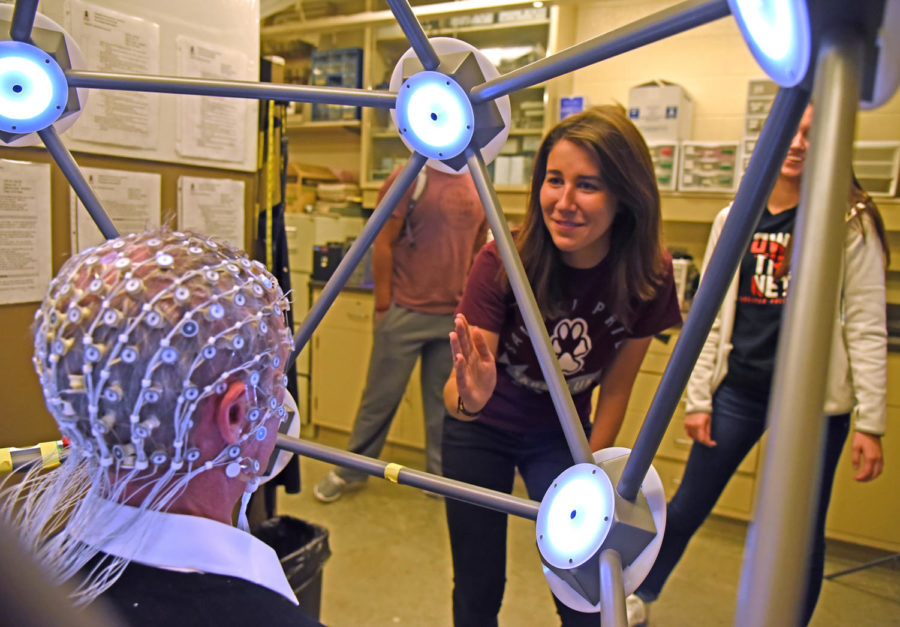Researchers inspect brain waves to predict if people will become heavy smokers
Emma Johns, a sophomore from Champaign studying physiology, directs a participant to align under a dome of cameras in order to image his head Thursday, Oct. 26, 2017. “I wanted to go somewhere that I could be involved in research, especially at a young age,” Johns said. “I didn’t want to wait until I was a senior.” (Cory Ray | @CoryRay_DE)
November 1, 2017
Some scientists on campus are conducting research to clear the air on whether they can predict if people will become heavy smokers.
Emma Johns, a sophomore from Champaign studying physiology, is helping conduct a study with psychology professor David Gilbert to examine the brain waves of social smokers aged 18 to 24.
“I feel like on college campuses, people are at pinnacle age where make a lot of decisions like, ‘This is where the parties happen,’ and they socially smoke,” Johns said. “They’re on this peak where they either don’t smoke or they progress.”
Advertisement
She began her work in the lab on her fourth day on campus.
“Right now, I think it’s really important for people to value research,” Johns said. “Nobody really notices the magnitude of what goes on.”
Gilbert said he’s been performing smoking-related research at SIU since 1985. Since then, he said technology has advanced so far he is able to expand his research to study genes.
“We study a number of genes, some of which will be neurotransmitters in the brain,” Gilbert said. “One of the transmitter-related genes is found to predict progression to heavier smoking.”
Participants are recruited to the lab for an 18-month study, in which the goal is to ultimately predict whether individual people are more likely to quit smoking, smoke less or smoke more by the end of the trial.
A total of 108 participants have taken part in this study since 2014 as part of a grant from the National Institutes of Health, researcher John Lindt said.
Like Johns, Britt Peyton — a freshman from North City studying physiology — began working in the lab when she first came to SIU.
Advertisement*
The lab has 10 undergraduate researchers and two graduate researchers, Gilbert said, and many of them start within their first or second year at SIU.
“We’re seeing that know what they want,” lab manager Norka Rabinovich said. “They have a vision of themselves. They know what their next step is beyond undergraduate.”
To conduct the study, Johns and Peyton place a net with 128 tiny suction cups on the participant’s head. Those suction cups act as electrical conductors which can measure brain waves, Gilbert said.
The brain waves are then depicted in a chart that will collect four hours of data. Variations in the chart can tell the researchers everything from if a participant blinked to how breathing nicotine in affects them.
The researchers also observe personality traits such as impulsivity, which Johns said can be indicative of a person progressing to becoming a heavy smoker.
“We can take all these predictors, correlate with each other and combine them in certain ways and then see which of these predict 18 month changes,” Gilbert said.
The participants are placed in a room where they perform a series of tests, such as watching a screen flashing with different images where they have to press a button when they see a certain image.
Lindt said mind tests can last up to 12 minutes each.
From there, Johns, Peyton and other researchers in the lab can determine aspects like how long it took participants to respond to something.
Then, a cigarette is burned in the chamber — the only place on campus where smoking is permitted — and the participant breathes in the smoke using a machine Gilbert designed in 1989. After that, the tests are repeated.
The machine gives different participants the same amount of nicotine across trials because some people respond more sensitively to it than other, Gilbert said.
“Since everybody smokes differently, this gives us the control if everybody was going to be smoking the same,” Lindt said.
Staff writer Cory Ray can be reached at [email protected] or on Twitter @coryray_de.
To stay up to date with all your southern Illinois news, follow the Daily Egyptian on Facebook and Twitter.
Advertisement









